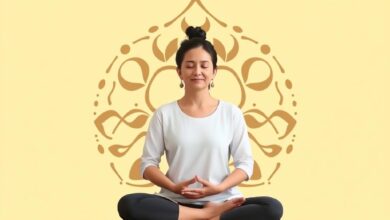How to release control and embrace uncertainty

To experience true freedom, cultivate a mindset of surrender. This involves consciously letting go of the need to dictate every outcome and allowing life to unfold naturally. By doing so, you open yourself up to unexpected opportunities and possibilities that can enrich your existence.
Trust is a fundamental element in this process. It requires faith in yourself and the universe, knowing that things will align as they should. Start by identifying areas in your life where you feel the urge to micromanage, then take a step back. Allow situations to develop without your interference; this act of relinquishment can be liberating.
Flow is another crucial aspect when learning to navigate unpredictability. Engage with experiences as they come, rather than resisting them. Practice mindfulness techniques such as meditation or deep breathing, which can help center your thoughts and enhance your ability to adapt effortlessly to shifting circumstances.
Understanding Your Need for Control
Identify the triggers behind your desire for dominance in various situations. Awareness is key. Ask yourself:
- What specific outcomes am I trying to achieve?
- How does my need for dominance impact my relationships and mental well-being?
- Am I responding to fear or past experiences?
Recognize that this impulse often stems from a fear of chaos or unpredictability. Acknowledge these feelings without judgment, allowing them to surface.
Shift your perspective by embracing the concept of flow. Practice mindfulness techniques like meditation or deep breathing to cultivate a state of presence. This allows you to surrender to the moment, creating space for freedom from rigid expectations.
Create small experiments where you intentionally relinquish control in low-stakes scenarios. For example:
- Let someone else choose the restaurant during a meal.
- Allow a friend to plan an outing without your input.
- Try an activity without a predetermined outcome, such as painting or writing freely.
Document your experiences. Reflect on how it felt to step back and observe the results. Often, you may find unexpected joy or insight in letting go of tight rein.
Cultivating acceptance involves recognizing that life’s unpredictability can lead to growth and new opportunities. Embrace uncertainty as part of your evolution rather than something to resist.
The practice of surrender opens pathways for creativity and spontaneity, enriching your experiences and relationships. Freedom lies in trusting that everything will unfold as it should, even if it diverges from your initial plans.
Recognizing Signs of Anxiety
Pay attention to physical sensations. Notice if you experience increased heart rate, shallow breathing, or muscle tension. These are indicators your body is reacting to stress. Acknowledge these feelings without judgment; they signal a need for surrender and flow.
Monitor your thoughts. If you find yourself caught in a loop of worry or overthinking, recognize this as a sign of discomfort with unpredictability. Challenge these thoughts by asking yourself how likely the feared outcomes are and whether they warrant such concern.
Observe changes in behavior. Withdrawal from social situations, procrastination on tasks, or compulsive habits may point to anxiety. Reflect on whether these behaviors stem from a desire for safety amidst chaos. Embrace the freedom that comes with engaging despite uncertainty.
Assess emotional responses. Frequent feelings of irritability, sadness, or frustration can indicate underlying anxiety. Allow yourself to feel these emotions fully; acknowledging them can lead to release and a greater sense of peace.
Identify avoidance patterns. If there are situations or responsibilities you consistently evade due to fear, this can highlight an attempt to maintain a grip on your surroundings. Recognize the potential for growth that exists in facing challenges head-on rather than retreating into comfort zones.
Create space for mindfulness practices. Incorporating techniques like meditation, deep breathing exercises, or journaling can help cultivate awareness of anxious feelings. These practices encourage letting go of rigid expectations and embracing the natural ebb and flow of life’s experiences.
Seek support when needed. Engaging with friends, family, or professionals can provide fresh perspectives on your struggles. Sharing your concerns fosters connection and reminds you that it’s okay to experience vulnerability in uncertain times.
Acknowledging signs of anxiety is crucial for finding balance. By recognizing these indicators without resistance, you open yourself up to new possibilities and foster resilience in the face of life’s inherent unpredictability.
Practicing Mindfulness Techniques
Focus on your breath. Inhale deeply through your nose, allowing your abdomen to expand. Exhale slowly through your mouth, releasing tension. Repeat this for several minutes, concentrating solely on the rhythm of your breathing. This practice cultivates trust in the moment and invites a sense of surrender.
Engage in body scanning. Lie down comfortably and mentally scan each part of your body from head to toe. Notice sensations without judgment; simply observe. This technique fosters awareness and provides freedom from overthinking.
Incorporate mindful walking into your routine. As you walk, pay attention to the sensation of each step–the ground beneath your feet, the movement of your legs. Allow yourself to be fully present in this experience, letting go of distractions.
Practice gratitude journaling daily. Write down three things you appreciate about each day. This exercise shifts focus towards positive aspects of life, reinforcing a mindset that embraces what is rather than fixating on what could be.
Try guided imagery sessions. Visualize a peaceful place where you feel safe and relaxed–this could be a beach or a forest. Immerse yourself in the details: sights, sounds, and smells. This mental escape encourages freedom from anxiety and promotes emotional well-being.
Adopt loving-kindness meditation. Silently repeat phrases wishing happiness and peace for yourself and others: “May I be happy; may I be healthy.” Cultivating compassion helps dissolve barriers and nurtures connection with those around you.
Schedule regular moments for stillness throughout your day. Set aside five minutes to sit quietly without distractions; focus on being present in the here and now, which can deepen trust in life’s unfolding process.
Cultivating a Supportive Environment
Create spaces where vulnerability is welcomed. Encourage open discussions about feelings and uncertainties within your community, whether at home or in social groups. This openness fosters connections that allow individuals to experience freedom in sharing their thoughts without judgment.
Establish routines that prioritize emotional well-being. Incorporate regular check-ins with friends or family members, creating opportunities for everyone to express themselves. These practices not only build trust but also promote a flow of support that nurtures resilience.
Engage in activities that encourage collaboration rather than competition. Group exercises, team projects, or community service can shift focus from individual performance to collective growth, reinforcing the idea of surrendering personal agendas for a common purpose.
Limit exposure to negativity by curating your environment. Surround yourself with uplifting materials–books, music, art–that inspire acceptance and resilience. The energy in these spaces can significantly influence mindset and overall outlook.
Model behaviors that reflect a healthy relationship with uncertainty. Share personal stories of navigating challenges without needing all the answers. This authenticity invites others to join you on this path of letting go, fostering an atmosphere where uncertainty becomes less daunting.
Encourage mindfulness practices within your circle. Group meditation sessions or shared moments of reflection can deepen connections while teaching the value of being present amidst chaos. This practice cultivates an appreciation for life’s unpredictability and enhances collective strength.
Embracing Change in Life
Focus on small, incremental shifts in your routine. This can open pathways to new experiences, fostering a sense of freedom. Each time you try something unfamiliar, you practice the art of surrender, allowing life to unfold without rigid expectations.
Engage with nature regularly. Whether it’s a walk in the park or simply observing clouds, immersing yourself in natural surroundings can enhance your ability to flow with life’s rhythms. Notice how the environment changes constantly; this serves as a reminder that transformation is part of existence.
Set intentions rather than fixed goals. Intentions provide direction while leaving room for spontaneity. For instance, instead of aiming for a specific job title, intend to find fulfilling work that aligns with your passions. This approach encourages adaptability and reduces pressure.
Incorporate daily rituals that promote relaxation and mindfulness. Simple acts like deep breathing or journaling create space for reflection and help you release tension associated with rigid outcomes. These practices cultivate an awareness that supports your capacity to let go.
Surround yourself with individuals who celebrate change and growth. Engage in conversations that inspire new perspectives and challenge outdated beliefs. A supportive community fosters resilience, making it easier to navigate life’s unpredictability.
Recognize moments when resistance surfaces; acknowledge them without judgment. Understanding these feelings allows you to respond more thoughtfully rather than reactively, enhancing your ability to adapt.
Ultimately, embracing change invites opportunities for personal growth. As you learn to flow with life’s currents, the potential for joy and fulfillment expands exponentially.







